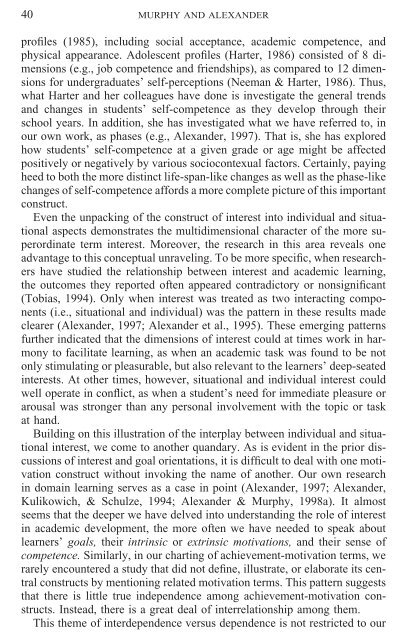A Motivated Exploration of Motivation Terminology - Anitacrawley.net
A Motivated Exploration of Motivation Terminology - Anitacrawley.net
A Motivated Exploration of Motivation Terminology - Anitacrawley.net
You also want an ePaper? Increase the reach of your titles
YUMPU automatically turns print PDFs into web optimized ePapers that Google loves.
40 MURPHY AND ALEXANDERpr<strong>of</strong>iles (1985), including social acceptance, academic competence, andphysical appearance. Adolescent pr<strong>of</strong>iles (Harter, 1986) consisted <strong>of</strong> 8 dimensions(e.g., job competence and friendships), as compared to 12 dimensionsfor undergraduates’ self-perceptions (Neeman & Harter, 1986). Thus,what Harter and her colleagues have done is investigate the general trendsand changes in students’ self-competence as they develop through theirschool years. In addition, she has investigated what we have referred to, inour own work, as phases (e.g., Alexander, 1997). That is, she has exploredhow students’ self-competence at a given grade or age might be affectedpositively or negatively by various sociocontexual factors. Certainly, payingheed to both the more distinct life-span-like changes as well as the phase-likechanges <strong>of</strong> self-competence affords a more complete picture <strong>of</strong> this importantconstruct.Even the unpacking <strong>of</strong> the construct <strong>of</strong> interest into individual and situationalaspects demonstrates the multidimensional character <strong>of</strong> the more superordinateterm interest. Moreover, the research in this area reveals oneadvantage to this conceptual unraveling. To be more specific, when researchershave studied the relationship between interest and academic learning,the outcomes they reported <strong>of</strong>ten appeared contradictory or nonsignificant(Tobias, 1994). Only when interest was treated as two interacting components(i.e., situational and individual) was the pattern in these results madeclearer (Alexander, 1997; Alexander et al., 1995). These emerging patternsfurther indicated that the dimensions <strong>of</strong> interest could at times work in harmonyto facilitate learning, as when an academic task was found to be notonly stimulating or pleasurable, but also relevant to the learners’ deep-seatedinterests. At other times, however, situational and individual interest couldwell operate in conflict, as when a student’s need for immediate pleasure orarousal was stronger than any personal involvement with the topic or taskat hand.Building on this illustration <strong>of</strong> the interplay between individual and situationalinterest, we come to another quandary. As is evident in the prior discussions<strong>of</strong> interest and goal orientations, it is difficult to deal with one motivationconstruct without invoking the name <strong>of</strong> another. Our own researchin domain learning serves as a case in point (Alexander, 1997; Alexander,Kulikowich, & Schulze, 1994; Alexander & Murphy, 1998a). It almostseems that the deeper we have delved into understanding the role <strong>of</strong> interestin academic development, the more <strong>of</strong>ten we have needed to speak aboutlearners’ goals, their intrinsic or extrinsic motivations, and their sense <strong>of</strong>competence. Similarly, in our charting <strong>of</strong> achievement-motivation terms, werarely encountered a study that did not define, illustrate, or elaborate its centralconstructs by mentioning related motivation terms. This pattern suggeststhat there is little true independence among achievement-motivation constructs.Instead, there is a great deal <strong>of</strong> interrelationship among them.This theme <strong>of</strong> interdependence versus dependence is not restricted to our
















